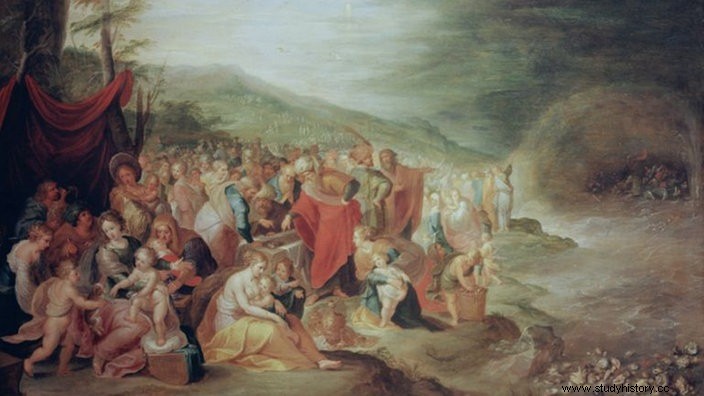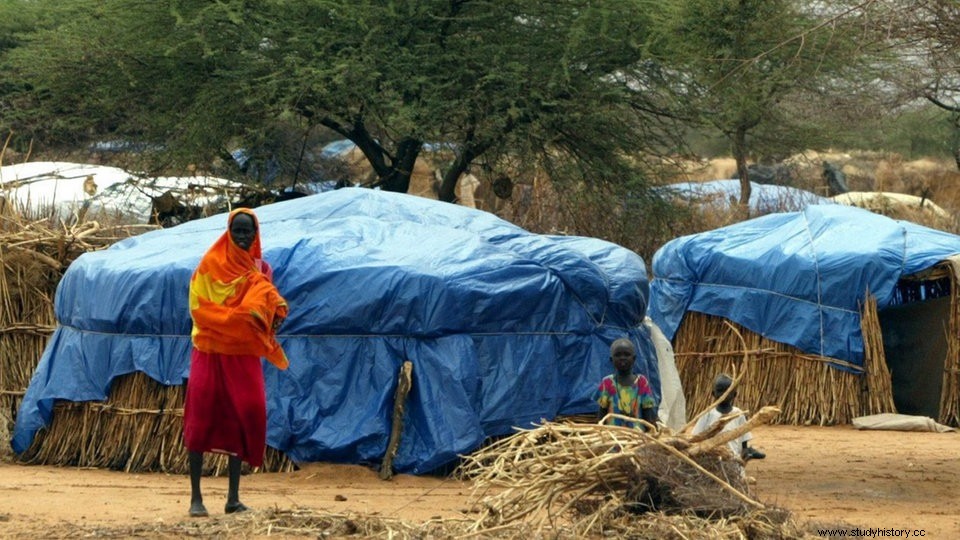Flight and expulsion have existed for as long as there have been people. War, hunger, environmental disasters - there are many reasons why people leave their homes.
From Biblical times to the Roman Empire
Already in the pre-Christian Bronze and Iron Age there were disputes between different tribes about hunting grounds, settlements and partners. The survivors of the defeated tribe then had to leave their homes and settle elsewhere.
Oppression and flight also play a major role in the Bible. So Moses is chosen by God to free the people of Israel from their slave existence in Egypt and leads his people to the promised land of Canaan. Many historians hold that the Exodus from Egypt in the Old Testament is based on actual historical events in the 13th century BC.

Biblical Refugees:Moses and the People of Israel
In ancient and Roman times, many ethnic groups were expelled because of their beliefs and culture. The end of the Roman Empire and the beginning of the Middle Ages are also closely related to mass refugee movements, often summarized under the rather trivializing term "Migration of Nations".
Fleeing from the Huns, a cavalry people advancing from Central Asia, many Germanic tribes made their way west. They asked to settle in the Roman Empire, which they were granted in 376 AD.
But the integration did not succeed, and there were uprisings. In the decades that followed, more and more tribes moved from the north and east into the Roman Empire, hoping for a better life economically and politically. As a result of the diverse movements of peoples, some of which were forced by force, Rome disintegrated into many smaller empires, in which the foundation stone for today's Europe was laid.
Globalized refugee movements in the 20th century
In the centuries that followed, there were repeated wars that led to flight and expulsion. Be it because of territorial interests, religious conflicts or racism. Such as the Thirty Years' War or the two world wars in the 20th century, as a result of which millions of people lost their homes.
Harvest failures were also a cause of refugee movements. In the middle of the 19th century, after several failed potato harvests and the resulting famine, almost two million Irish made their way to America, Australia and Great Britain.
Refugee movements have become globalized since the end of the 20th century. Although armed conflicts are still often the cause, other reasons why people leave their homes are increasingly playing a role:poverty, hunger, environmental disasters and a lack of life prospects. Interventions in nature, such as river straightening or dams, always result in people fleeing.
The Western industrial nations currently promise the most security and prosperity and have therefore become the destination of millions of refugees from poor and conflict-ridden regions, especially from Africa and Asia. The USA and the countries of the European Union are particularly popular destinations.
The refugees accept great hardship and high financial burdens and often risk their lives - for example when crossing from North Africa through the Mediterranean Sea. And even if they manage to enter the country, it often happens that they are not recognized as asylum-seeking refugees and are deported back to their home country.

Millions of people lost their homes in World War II
Definitions:refugees, asylum seekers, migrants
In 1951, the Geneva Refugee Convention, commissioned by the United Nations, defined exactly who is considered a refugee in order to offer those affected a legal protection framework. A refugee is defined as a person who is outside their home country because they are at risk of persecution there because of their race, religion, nationality, political opinion or membership of a particular social group.
The states that have joined the Refugee Convention guarantee refugees basic care. In addition, they are entitled to religious freedom, they can appeal to ordinary courts, they are issued a travel document and they are to be protected from discrimination. In addition, a refugee must not be sent back to a country where they are at risk of persecution.
In addition, there is a right of asylum in some countries, including Germany. This also grants protection to people who are politically persecuted in their home country. German asylum law recognizes asylum seekers however not if they entered the country via a so-called "safe third country". The pursuit must also be targeted and based on the personal characteristics of the applicant; general emergencies such as famine or environmental disasters in the home country are not recognized.
Migrants do not fall under the Geneva Refugee Convention :People who leave their home country for economic reasons or who flee from environmental disasters, wars or hunger. Each country regulates the admission of migrants individually, there are no binding guidelines as there are for refugees, although both groups often go the same way.
But there are also situations where some countries recruit people from other countries to work. In the 1950s and 1960s, guest workers from Italy, Turkey and Greece were specifically recruited in Germany to cover the need for workers. When the economic situation worsened in the 1970s, stricter regulations were enacted.

In Myanmar, the Karen ethnic group is persecuted by the state
Help from international communities, countries, private organizations
The offers of help for refugees are organized at different levels. In 1950, for example, the United Nations Refugee Agency (UNHCR) was founded, which advocates for the rights of refugees and compliance with the Geneva Convention and provides help in crisis areas.
In 1992, the European Union (EU) set up a Directorate-General for Humanitarian Aid (ECHO) and is active in almost every crisis region in the world. In addition, the EU is one of the largest donors of official development cooperation. Programs for economic development, health improvement and poverty reduction should help to reduce the reasons for a possible flight.
Individual states also provide assistance for economic development in the form of emergency programs and bilateral agreements with partner countries. In addition, the handling of refugees is regulated at state level in the form of asylum legislation. For example, a person entitled to asylum in Germany receives a residence permit that is initially limited to three years and, under certain conditions, is entitled to social benefits.
The Federal Office for Migration and Refugees provides help with the integration of refugees who want to stay in Germany, for example through language courses and legal advice.
In addition, many non-governmental organizations (NGOs) are involved in refugee aid. Organizations and associations such as the Red Cross, Red Crescent, Doctors Without Borders, terre des hommes or Cap Anamur, which are committed to the common good, help in emergency situations and take care of refugees on site. Due to their lean structures and sometimes short decision-making processes, NGOs are often more flexible and therefore able to provide help more quickly than government agencies.

The Red Cross takes care of refugees worldwide
71 million displaced people
Despite the growing offers of help from various quarters, the situation for refugees has not improved in the new millennium. According to a report by the United Nations, around 71 million people were displaced worldwide in 2018.
While 26 million people have fled to other countries, the number of so-called internally displaced people who are being forced to flee within their home country has risen sharply. At 41 million, internally displaced persons now make up the largest proportion of people who have lost their homes.

Millions of refugees live in camps in Sudan
